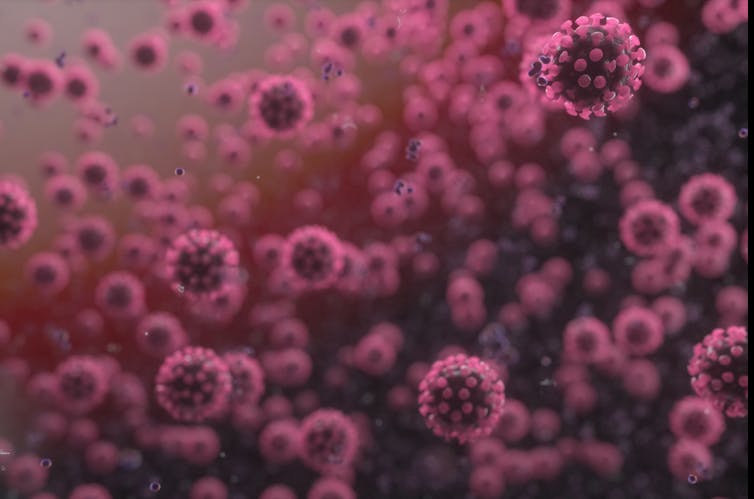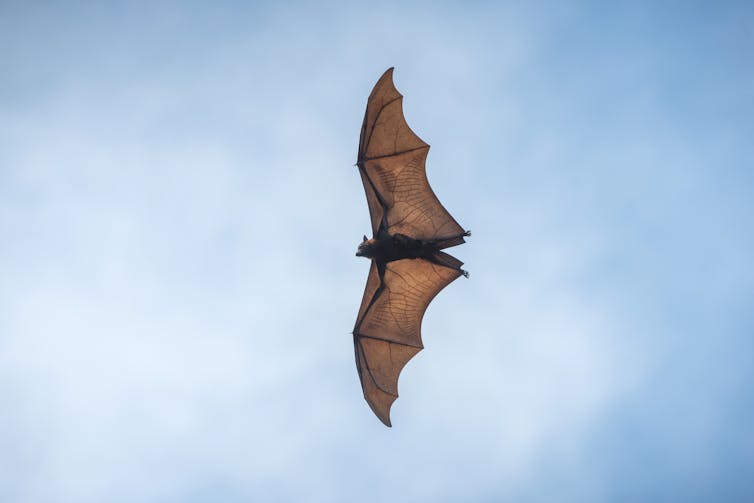Marcos E. García-Ojeda, a professor of molecular and cell biology, answers five questions about viruses.

By Marcos E. García-Ojeda
University of California, Merced
Editor’s note: The coronavirus, which has claimed more than 51,000 lives worldwide and sickened 1,001,069 most likely originated in bats, most experts believe. From bats, the virus “jumped” to another species, likely pangolins, and then to humans. Why didn’t the virus make bats or pangolins sick? As it turns out, viruses are complicated – in addition to sometimes being deadly.
1. How Does this New Virus Differ from Other Coronaviruses?
The family Coronaviridae contains about 39 different species of coronaviruses. Of these, only seven coronaviruses have been reported to infect and cause disease in people. Four coronaviruses cause mild symptoms similar to the common cold, but three coronaviruses cause severe and possibly deadly infections: the severe acute respiratory syndrome coronavirus (SARS-CoV), the Middle East respiratory syndrome coronavirus (MERS-CoV), and now, SARS-CoV2, which is responsible for the current coronavirus disease COVID-19.
SARS-CoV2 is a cousin of the coronavirus that caused SARS, having about 79 percent similarity in its genetic makeup. Though similar, these two viruses are not the same, and their disease manifestations are different. SARS was recognized at the end of February 2003 in China. Worldwide, 8,098 people became sick with SARS and 774 died, with the disease having a mortality rate of 10 percent.

MERS-CoV was first identified in Saudi Arabia in September 2012. Globally, MERS-CoV was responsible for 2,494 MERS cases and 858 deaths, with a mortality rate of 37 percent.
The ongoing SARS-CoV2 epidemic and the rate of infection and mortality seem different than both SARS-CoV and MERS-CoV. As of April 1, the U.S. has 215,344 Covid-19 cases. It seems that SARS-CoV2 is less deadly than the other two coronavirus strains, but it is more contagious.
2. Some People are Saying COVID Might Become Endemic. What Does this Mean?
Aggressive diseases like SARS give rise to epidemics – outbreaks where the number of new cases flares up rapidly in a region. Effective, evidence-based public health measures reduce the number of new patients infected, until these aggressive diseases are controlled. In contrast, an endemic disease is constantly present in a certain geographic region. A good example of an endemic disease is malaria, which is constantly present in tropical regions of Africa, Asia and Latin America.
The 2003 SARS epidemic was controlled by a combination of effective international surveillance methods and local, evidence-based public health measures. International surveillance systems alerted the authorities of the emergence of a novel disease, helping set up guidance for travelers, airlines and crew. It also set in motion a global response that prevented the spread of the disease, and helped the local public health efforts to identify and quarantine infected people. Effectively, this combined response prevented SARS from becoming endemic.
By July 2003, four months from the onset of the outbreak, human-to-human transmission of SARS had stopped.

3. How Do These Viruses Jump to Humans?
The majority of new diseases affecting humans are zoonotic, meaning that they originate in wild animals (mostly mammals) and then cross over to people. Among mammals, bats have a higher number of zoonotic viruses. These viruses might cause mild to no symptoms in bats. People and animals interacting with bats (or their urine, feces or saliva) might catch these zoonotic viruses and then spread them to other animals or people.
The trapping of wild animals for pets, food or medicinal purposes puts wild animals like bats in close contacts with other animals and people. That is what happened in the previous two coronavirus outbreaks. In the 2003 outbreak, the SARS coronavirus jumped from bats to civets being sold as food in a market, and then from civets to people. In the MERS outbreak, the MERS coronavirus jumped from bats to camels and from camels to people. As a result of the COVID-19 epidemic, China placed a permanent ban on wild animal markets.
4. Why Don’t Bats Get Sick from the Virus?
Bats are pretty incredible animals. They are the only mammals that fly. Scientists have linked the genetic modifications associated with flight with beneficial modifications to the bat’s immune system. For example, the bat’s immune system fights viral infections but does not overreact to them, preventing bats from falling ill from the many viruses they have.
5. How Do Organisms Reach a ‘Truce’ with a Virus?
The outcome of a virus infecting an animal depends on two general factors: The first is how strong, or virulent, is the strain of the virus. The second is the effectiveness of the infected animal’s immune defenses. Initially, a virus might be highly lethal to animals. Rapidly killing its host is not beneficial to the virus because it limits the virus’s capacity to spread to other animals. Therefore, the virus become less virulent with time. On the other hand, animals sensitive to the virus die quickly, while animals with inherited resistance to the virus survive, passing that resistance to their offspring. This combination of events, over a large period of time, results in an equilibrium where the animal’s immune system is able to control a virus infection without completely eradicating it. In people, this type of equilibrium could be observed with herpes infections.
Marcos E. García-Ojeda, professor of molecular and cell biology, University of California, Merced.
This article is republished from The Conversation under a Creative Commons license. Read the original article.
The views expressed are solely those of the author and may or may not reflect those of Consortium News.
Please Donate to Consortium News.
Before commenting please read Robert Parry’s Comment Policy. Allegations unsupported by facts, gross or misleading factual errors and ad hominem attacks, and abusive or rude language toward other commenters or our writers will not be published. If your comment does not immediately appear, please be patient as it is manually reviewed. For security reasons, please refrain from inserting links in your comments, which should not be longer than 300 words.

Why are these viruses affecting us now and in these locations?
Time and chance come to us all.
We must respect Nature and not destroy animals’ living spaces. The more we destroy their habitats the closer they move into ours, looking for sustenance.
I, for one will have all my family members read and understand the information given by Professor Marcos Garcia-Ojeda.
Perhaps the weaponize anthrax was sent out from Fort Detrick after the demolition of the World Trade Center
and made to look like it was sent from a foreign actor
has make some Americans suspect that the MIC might also be experimenting with weaponizing viruses.
While flying and echolocation abilities of bats are remarkable, I am guessing that their habit of roosting in large numbers facilitates rapid spread of microorganisms among bats, and thus very strong selection pressure to have good immune system. Thus we have a case of co-evolution: viruses that survive in bats can exists with their immune system, and bats can thrive in the presence of viruses.
We all carry viruses with little harm, like occasional sniffles or herpes outbreaks. Actually, without modern medicine, I am not sure if my bout of shingles would end well.
One thing I learned last year is that humans inherited two genes for so-called theta defensins. These defensins offer protection against immunodeficiency syndrom viruses in primates, but humans have pseudogenes. After leaving tropical forests for savannas few hundred thousands years ago, theta defensins were not needed and the useless genetic code got corrupted with mutations. So we pay the price for not staying in the same environment for several million years. There are advantages of that, but there is also a price.
Thanks for bringing facts and objectivity to this unfolding catastrophe. Unfortunately, far too many Americans (and others) believe the most ridiculous things about the natural world, the motives and actions of the biomedical community, and supposedly hidden government policies intended sabotage our own public health and well-being. Just read the forums on any number of other web sites focusing on this issue. The proffered (pseudo)scientific analyses are nothing short of fantastical and their recommendations only damaging to the gullible. Some treat viruses as evil spirits, or dysfunctional thinking, or the body turning against itself because… food additives, GMO’s, chemtrails, racism, insidious “Chi-coms,” vaccines, the wrong politics, or you name it. The universals these loons are united on is that the whole thing is a hoax, this virus is harmless to most people, there is no reason to adhere to social distancing policies, it was all concocted to justify another bailout for the rich, and the doctors, the politicians and the media are all lying to them. Hopefully, such people do not represent the majority within the public. We can fairly debate the origin of the virus, America’s preparedness (or lack thereof) to counter the pandemic and the concrete actions taken to mitigate it even as we collect data as to the efficacy of the latter, but it is beyond belief to deny what is happening before our eyes and in the context of a robust science which has afforded us a fairly good understanding of the problem in rather great detail. Again, thank you, professor, for your illuminating contribution.
I would dispute the reliability of the “facts” in this article. Particularly the rates of infection, and the subsequent mortality rates. Especially with COVID-19, but even with SARS and MERS, we have no accurate idea what the infection rate is because we don’t have sufficient testing. I read two articles in the off-guardian that quotes experts who have been shut out of the discussion in the MSM. One suspected the rate of infection may be ten times higher than reported. Someone did a sampling of the general population, and found that only roughly one in ten who tested positive showed any symptoms. And, as far as I know, the theory that the virus came from Chinese bats has not been conclusively proven. I don’t think it’s time to take off your tin-foil hat just yet. Event 201 has me keeping mine on.
Skip, my issue is with the folks who claim there is NO pandemic, this is all an orchestrated hoax, that it’s nothing to worry about because the symptoms are mild in most people, that some segments of our population with predispositions are dispensable, that money is more important than lives, or that proper attitude or some other hocus pocus will see you through.
I’ve read crap that must have been written by space aliens because the biology they seem to understand does not describe any on this planet… like they don’t accept that viruses exist or that this disease is caused by a virus. They are confused (or more like ignorantly defiant) about the physico-chemical make-up of a virus, about host-parasite relationships in general, and about the co-evolution of a virus and its host.
As I said in my comment, any discussion you want to have about the origin of the isolated strains of this virus is still totally open for debate. A number of scenarios seem to have circumstantial support. To postulate that the virus may have a laboratory origin (whether deliberate or not) is not to be conflated with a claim that the pandemic is a hoax. The pandemic is very real whether natural or man-made. It is very serious, especially among some segments of the population (and not “merely” old people). And EVERYONE has a duty to avoid contracting it and passing it along in a chain of infection, not just the “most at risk.”
I agree with you about the lack of testing leading to what’s undoubtedly a massive under count of the case load (by a factor of anywhere between 10X – 100X). Besides THAT lag, there is also the “incubation” period of as long as 24 days to take into account, which also deceives us into early complacency. Consequently, we may be way behind the curve on trying to stop the spread of this disease. So many incipient victims are probably already in the pipeline to manifesting a full blown disease, but neither they nor the health department know this yet. This may lead people to fallaciously conclude that it is futile to use these tools of social distancing and lockdowns to mitigate events and prompt the president to simply “open America for business” far too prematurely, making matters much worse.
My thanks to the professor was for his teaching simple understandable facts about viruses, and most especially the corona virus family, rather than merely manipulating a bunch of mathematical relationships and data sets, which is what most analysts from the biomedical community are wont to do. I didn’t even consider his presentation to be taken as a definitive account of this pathogen’s proximal origins. To say it originally evolved in bats does not preclude bioengineering it to thrive in humans. The apparent strain specificity observed in distinct human populations has me skeptical about the mainstream media account of spontaneous jumps from bat to pangolin to humans… at least three or four times!
Realist-
Please read article at Global Research dated 4/03 by F. William Engdahl regarding corruption at the WHO. I think our level of trust in that institution should be about the same as the OPCW. I am not arguing that COVID-19 is a hoax, or is not dangerous. I am arguing that there is a level of conspiracy to use the COVID-19 pandemic for nefarious purposes.
Skip, Since the WHO is a creature of the United Nations, I frankly doubt that the United States government has any use for the institution, as we have divorced ourselves from most other similar UN programs such as UNESCO. It is my understanding that we don’t financially support them nor promote them. If we can’t thoroughly control an operation, we diminish it with propaganda and try to eliminate it. I can’t say I’ve heard or read much of the WHO’s comments on the current Covid-19 outbreak. It’s like they’ve been hiding out with Joe Biden.
All that said, perhaps the organisation is, in fact, rife with corruption. That potential issue has been pretty much off the entire media’s radar, including the independent venues. I’ll say this: the economic collapse in this country was a major crisis just waiting to happen. It would have taken place whether Covid-19 ever became a thing or not. Respected analysts from both the Left and the Right have been predicting it would happen at any time over the past 3-4 years. It’s been like Tom Hartman’s favorite topic in the world since forever.
Covid-19 may very well have been disingenuously used as the excuse for TPTB to pull the trigger that we saw happen in Congress the other day. Wouldn’t surprise me in the least. They’ve got more of the same planned, based on the remarks made by our esteemed legislators. That cabal was not the people I was taking issue with in my original comment. My targets were the fools who absolutely refuse to apply hard science to the problem, or who somehow manage to distort the science beyond all recognition and who believe they are geniuses rather than the imbeciles they actually are. I thanked the professor for providing the necessary starting point in the science of virology. Maybe I just should have said have a read on viruses in Brock’s “Biology of Microorganisms” and learn even more, for there’s a lot to all this which is well understood on the biological level and not a ruse.